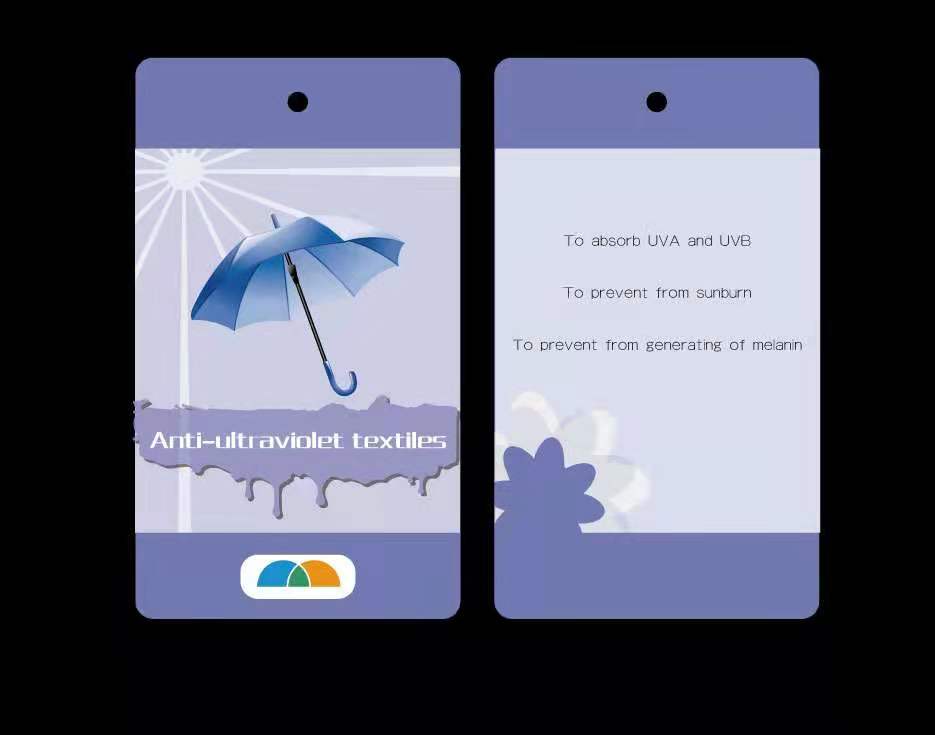
Ultraviolet rays not only fade and embrittle textiles, but also produce melanin and stains on the human skin. More serious, it can also induce cancer. It is necessary to protect it. The principle of ultraviolet protection is to use ultraviolet absorbers and reflectors to treat fibers or fabrics. The ultraviolet absorbers absorb high-energy ultraviolet rays and convert them to low-energy, turning them into low-energy heat or short-wavelength electromagnetic waves. To eliminate the harm of ultraviolet rays to the human body and fabrics, ultraviolet reflectors can increase the reflection and scattering of ultraviolet rays by fabrics, and prevent penetration of fabrics.
Beijing Jiershuang High-Tech Company is a manufacturer of anti-ultraviolet finishing agent. The anti-ultraviolet AU-100 anti-ultraviolet finishing agent has been put on the market in large quantities for 20 years. JLSUN® anti-ultraviolet finishing fabric meets the Chinese standard "GB/T18830-2009 Evaluation of Textile Anti-ultraviolet Performance", Australian/New Zealand standard AS/NZS 4399:1996, European Union standard EN13758-1:2001 and EN13758-2:2003, American AATCC183 -2004, ASTMD 6544 and ASTMD 6603, British Standards BS8466-2006, BS7914-1998 and BS7949-1999, International Certification Association Standard UV Standard 801 and other domestic and foreign standards. Jiershuang laboratory provides customers with free testing of the anti-ultraviolet effect of fabric.
Product traits and technical indicators
Anti-ultraviolet finishing agent AU-100 contains an ultraviolet absorber, the main component of which is a benzotriazole compound. AU-100 is suitable for the anti-ultraviolet finishing of cotton, silk, linen, viscose and polyester-cotton fabrics. The treated fabric has a good absorption effect on ultraviolet rays in the 180-400nm band, especially UV-A and UV-B. Finishing After the JLSUN®JC 40×40 110/90 pure cotton fabric, the UPF value is still as high as 50+ after 40 washings.
Anti-ultraviolet finishing agent AU-100 is non-toxic, non-explosive, safe to the human body, non-irritating to the skin, does not contain harmful substances such as formaldehyde and heavy metal ions, and meets environmental protection requirements. AU-100 does not affect the color, strength and moisture permeability of the fabric. The appearance of AU-100 is light yellow liquid, the content of active ingredients is more than 30%, the pH value is about 7, the ionicity is non-ionic, and it is miscible with water.
Instructions for use
The method of finishing the fabric can be padding, dipping, coating or spraying. The dosage is usually 2-4% (o.w.f.). The specific dosage and usage depend on the type, specification and purpose of the fabric. Polyester fleece fabrics mostly use the impregnation process, and woven fabrics mostly use the padding process, depending on the situation.
1. Process formula: (take the rolling rate of 65% as an example)
Anti-ultraviolet finishing agent AU-100 20-50 g/l
Fixing agent SCJ-963 20-50 g/L
2. Chemical operation: (take the preparation of 500 liters of solution as an example)
First, add about 400 warming water (30-50℃) into the chemical material tank, stir and add AUV-100, then add SCJ-963, stir evenly, finally add water to 500 liters, continue to stir, (discharge tube of chemical material tank Add filter bag).
3. Process flow:
bleached and dyed fabric → padding with anti-ultraviolet solution → drying (80-110℃, 2-3min) → tentering setting (150-170℃, 30s)
4. Points to note: After padding the anti-ultraviolet solution, prevent migration during drying (infrared or hot air pre-baking is preferred).
Packaging and storage: 25Kg plastic barrels, stored in a cool warehouse above 0℃, storage period of one year.
